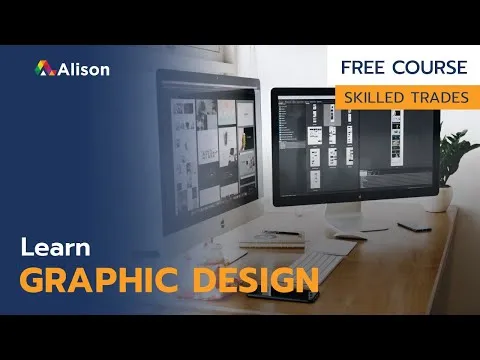
Graphic Design Tips & Tricks Weekly 
John McWade's weekly series provides designers of all levels with the tips and tricks they need to create more powerful work and hone their skills. Learn from the expert and take your design to the next level. ▼
ADVERTISEMENT
Course Feature
![]() Cost:
Cost:
Free Trial
![]() Provider:
Provider:
LinkedIn Learning
![]() Certificate:
Certificate:
No Information
![]() Language:
Language:
English
![]() Start Date:
Start Date:
Self Paced
Course Overview
❗The content presented here is sourced directly from LinkedIn Learning platform. For comprehensive course details, including enrollment information, simply click on the 'Go to class' link on our website.
Updated in [March 06th, 2023]
This course, Graphic Design Tips & Tricks Weekly, provides an overview of all areas of design, helping designers new and old sharpen their skills and create more powerful work. Each episode covers a different topic, from typography and layout to color and logo design, and can be completed in ten minutes or less. This course is ideal for those looking to gain a better understanding of the fundamentals of graphic design and how to apply them to their own projects.
[Applications]
After completing this course, participants can apply the tips and tricks they have learned to their own graphic design projects. They can use the techniques to create more powerful and effective designs, as well as to improve their overall design skills. Additionally, participants can use the course as a reference to review and refresh their knowledge of graphic design principles.
[Career Paths]
1. Graphic Designer: Graphic designers create visual concepts, using computer software or by hand, to communicate ideas that inspire, inform, and captivate consumers. They develop the overall layout and production design for various applications such as advertisements, brochures, magazines, and corporate reports. With the rise of digital media, graphic designers are increasingly being called upon to create designs for websites, mobile applications, and other digital platforms.
2. User Interface Designer: User interface designers create the look and feel of websites, mobile applications, and other digital products. They are responsible for creating user-friendly interfaces that are visually appealing and easy to navigate. As technology continues to evolve, user interface designers must stay up-to-date on the latest trends and technologies to ensure their designs are modern and effective.
3. Motion Graphics Designer: Motion graphics designers create animated graphics for television, film, and other digital media. They use a variety of software programs to create motion graphics that are visually appealing and engaging. Motion graphics designers must have a strong understanding of animation principles and be able to create graphics that are both aesthetically pleasing and technically sound.
4. Web Designer: Web designers create the look and feel of websites. They are responsible for designing the layout, navigation, and other visual elements of a website. As technology continues to evolve, web designers must stay up-to-date on the latest trends and technologies to ensure their designs are modern and effective.
[Education Paths]
1. Bachelor of Fine Arts (BFA) in Graphic Design: This degree program provides students with a comprehensive understanding of the principles and techniques of graphic design. Students learn how to create visual solutions to communication problems, develop a portfolio of work, and gain an understanding of the history and theory of design. This degree is ideal for those looking to pursue a career in graphic design, as it provides the necessary skills and knowledge to succeed in the field.
2. Master of Fine Arts (MFA) in Graphic Design: This degree program is designed for those who want to take their graphic design skills to the next level. Students learn advanced techniques in design, typography, and digital media, as well as the history and theory of design. This degree is ideal for those looking to pursue a career in graphic design, as it provides the necessary skills and knowledge to succeed in the field.
3. Certificate in Graphic Design: This certificate program provides students with a basic understanding of the principles and techniques of graphic design. Students learn how to create visual solutions to communication problems, develop a portfolio of work, and gain an understanding of the history and theory of design. This certificate is ideal for those looking to pursue a career in graphic design, as it provides the necessary skills and knowledge to succeed in the field.
4. Digital Media Design: This degree program focuses on the use of digital media in graphic design. Students learn how to create digital artwork, develop interactive websites, and create digital media campaigns. This degree is ideal for those looking to pursue a career in digital media design, as it provides the necessary skills and knowledge to succeed in the field. Additionally, this degree is becoming increasingly popular as digital media continues to grow in importance in the design industry.
Course Syllabus
Introduction
The Best Practices of Graphic Design
Design a modern cover: Think simple, clean, and angular
Sheet: Put your words here, not there
Design a business card: Make it look like what it says
Double your artwork for free: Use the same picture twice
Design a ghosted logo: A picture always goes with itself
Design a business card using repetitive shape
Why round letters are bigger than straight ones
Design a powerful poster: Work with your photo, not against it
Design stationery that’s almost a brochure: Picture your product, not your logo
Alignment: Your ruler’s good only for regular things
Logo design: Think simple
Your design needs a focal point: Dramatic photo anchors a strong makeover
Chart your data with images
Make a beautiful logo with off-the-shelf type
How to transfer your look to a new format
Angles
The (very!) versatile art of the silhouette
Easy, functional one-line design
Signage: Consistency makes the brand
Elementals: How black, white, and gray make depth
A beautiful desk calendar you can make yourself
Lesson of the counterintuitive logo
How to design visual instructions
Design a beautiful CD package
Simple brochure presents your face to the public
Soften the edge
Small layout packs a big punch
Shape it: Part one
Shape it: Part two
A logo makeover: Part one
A logo makeover: Part two
Grid collage
People in a group on a grid
Magazine cover redesign
Designing cards with type alone
Designing a small-space advertisement
Designing a business card for a photographer
Designing names with type and basic shapes
Review of an outdoor sign logo
Creating a small multipage brochure
Designing with black, white, and gray
Gestalt techniques: Isomorphism
Redesigning a business card
How to put motion on a static page
The color wheel
Layout decision points
Designing a tiny brochure
Panoramic spacing
Multi-use format for a business card
The boring book cover challenge: Part 1
The boring book cover challenge: Part 2
The single space practice
Incorporating hairlines into your design
Close enough with color choice
More design techniques with grids
Lanzarote calendar assignment
Foreground focal point
Stop, look, observe
Working with a rule of thumb (dynamic) grid
The humble power of negative space
Go with the flow
Learning by doing
For the love of design!
The boring book cover challenge, part 3
Bold moves
Simply beautiful
Common but versatile looks
Audacious philanthropy
Simple slides
Every face has a place
Those little extras
Seeing sight lines
Swiss style grids, part 1
Swiss style grids, part 2
Poetic type
Visual continuity
Find your balance
Looking around: Why it works
Don't fake it
Find the focal point
Tooth and texture
Small and simple
Design challenge: Dino Water
Looking around: Address the audience
Experimenting with borders
Magazine layout triple threat
Product ad comparison
Lanzarote calendar assignment: Revisited
Rewind: Simply beautiful
Rewind: Seeing sight lines
Course Provider

Provider LinkedIn Learning's Stats at AZClass
Discussion and Reviews
0.0 (Based on 0 reviews)
Explore Similar Online Courses

Use Airtable as a CMS for Gatsby Learn With Jason

Digital IC Design

Python for Informatics: Exploring Information

Social Network Analysis

Introduction to Systematic Review and Meta-Analysis

The Analytics Edge

DCO042 - Python For Informatics

Causal Diagrams: Draw Your Assumptions Before Your Conclusions

Whole genome sequencing of bacterial genomes - tools and applications

Complete Graphic Design Course Explaining Psychology (MUST KNOW)

Graphic Design Tutorial For Beginners Graphic Design (Full Course)


Start your review of Graphic Design Tips & Tricks Weekly